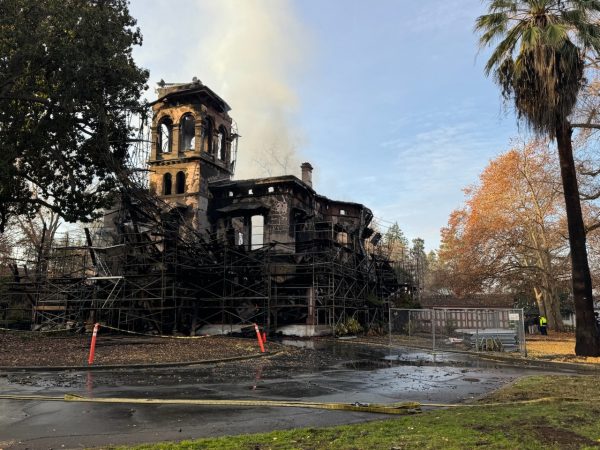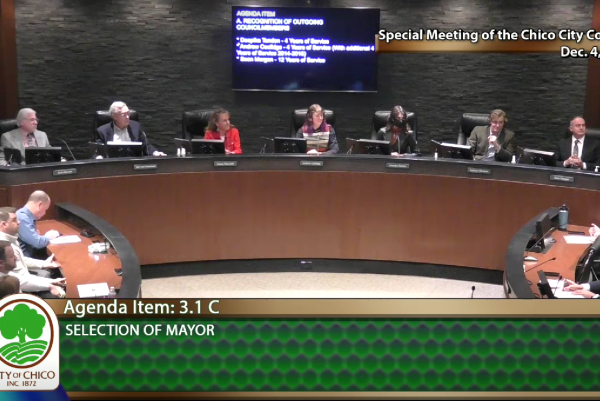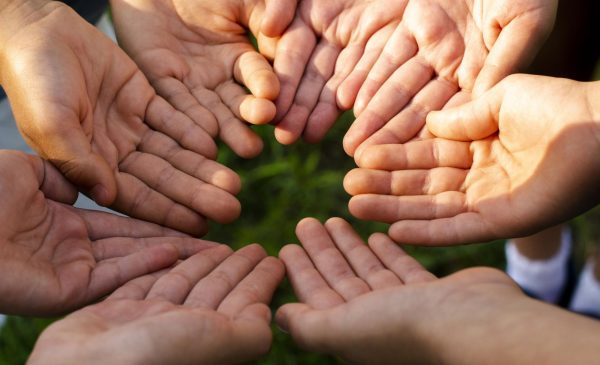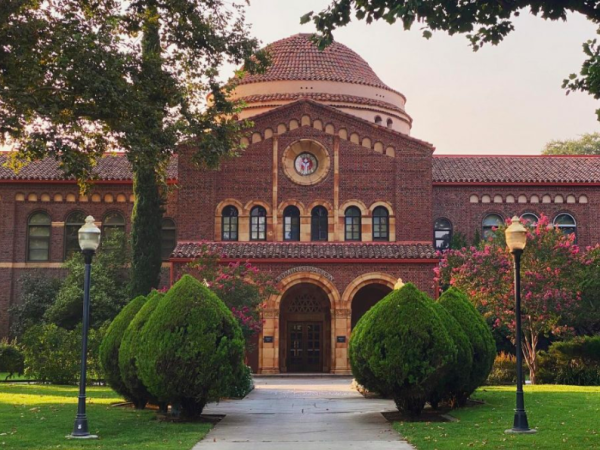Intersectional ecofeminism discussed at the 23rd annual women’s conference
Fall leaves coloring Chico State campus. Photo taken Nov. 13 by Ava Norgrove
Chico State’s Gender & Sexuality Equity Coalition held its 23rd annual women’s conference on Saturday to discuss how different forms of oppression overlap in regards to the climate crisis and personal identity. This year’s theme: intersectional ecofeminism.
The conference took place inside Bell Memorial Union. The conference featured keynote speakers PhD student Elybeth Alcantar and forest therapy guide Blake Ellis, with activities led by Alcantar, activist Daisy Chaves, counselor Angie Hensley and GSEC interns from 10 a.m. to 5 p.m.
Keynote speaker Elybeth Alcantar took the stage first to talk about Indigenous reflections on ecofeminism.
Alcantar is a first-year doctoral student in the Department of Geography and the Environment at University of Texas at Austin and a Lozano Long Institute of Latin American Studies, Foreign Language and Area Studies fellow.
Alcantar began the conference by telling the audience that before she is a geographer or student, she is a daughter, a granddaughter and an extension of her community. She said this is what shapes and influences her view of ecofeminism.
She identifies as Mixtec — a proud community in the Mixteca region of Oaxaca, Mexico, who derive their politics through indigenous systems of governance.
Alcantar began her research on the community in 2018, detailing the history prior to, during and after protests in the city of Nochistlan.
In 2016, primary school educators and communities across Oaxaca protested political reforms passed in 2013. These structural reforms created by the World Bank and the Organization for Economic Cooperation and Development continued the illegal privatization and leasing of nearly 40% of Oaxaca’s mostly indigenous communal lands to private companies.
Her village was affected by Operation Oaxaca, an army operation deployed under the Oaxacan governor’s orders and led by the Federal Preventive Police to put an end to the protesters’ blockades. At least 6 civilians were killed, and over 100 injured, Alcantar said.
Alcantar traveled to Oaxaca to record oral testimonies of those affected by the violence there.
Teachers told Alcantar that she should visit the nearby primary school to see what students were learning in the classroom and what community members were advocating.
Alcantar was heartbroken when she saw a poster created by a third grade class: brown butcher paper with images of animals and plants followed by the words, “El aqua es vida, cuidala.”
Water is life, care for her.
Beside it were drawings of dead fish and smoggy skies followed by the words, “La contaminación exterminio.”
The pollution exterminated here.
She spoke about current environmental battles like the Dakota Access Pipeline led by indiginous communities. Water is life, she repeated, and indigenous peoples are still caring for her.
Alcantar drew her speech to a close with a final look at feminist geopolitics and how it is concerned with gender as a critical variable alongside disparities, inequality, exclusion and violence based on other acts of oppression such as race, ethnicity, sexual identity and disability, among others.
Through this, she said, the connections between the global processes of displacement due to climate pollution can be easily mapped out.
“I urge you all here to listen to as many voices of indigenous land defenders, water defenders and the collective voices of the millions impacted by the climate crisis,” Alcantar said. “There is no one voice or one story, rather millions of people like me and you who are finding our voices throughout this struggle.”
After Alcantar’s speech, participants could join one of two workshops; “Go With the Flow,” by Daisy Chaves or a “Body Mapping” presentation led by Alcantar.
Chaves’ “Go with the Flow,” workshop delved into the ecological and social impacts of menstruation, which began with a look at how other cultures view menstruation and the historical stigma surrounding it in countries across the world.
Chaves addressed the current cultural practices that segregate menstruating women from male populations and bar them from going to school or cooking their own food.
There is a lack of bathrooms designed for menstruating people in developing countries with weak plumbing and a lack of waste bins for discarded hygiene products, she said. This makes something as simple as using a public restroom very difficult for people who menstruate.
“With menstruation,” Chaves said, “comes socialized shame.”
The stigma that menstruating is a terrible thing and should be kept secret, Chaves said, has a lot to do with how the media portrays menstruating people: always moody and angry. People don’t want to be mocked or have their feelings invalidated.
This results in very young people developing an unhealthy view of their cycle before they even experience it.
“So how do we break the stigma?” She asked the group.
Equal access and unsegregated comprehensive sexual education is the key, Chaves said. We must ensure that menstrual products are safe, affordable and available for those who need them. The ability to access these items affects a person’s freedom to work, study, be healthy and participate in daily life with basic dignity.
Chaves said the average person can spend up to $12,000 on menstrual products in a lifetime. Not everyone can afford that, so not everybody has access to these products.
Chaves spoke about the environmental costs of these products and the unsustainable ways in which they are manufactured. It’s no secret that plastics are one of the biggest pollutants on Earth, she said. A single tampon applicator can take up to five to eight years to break down, whether it’s in the landfills, oceans or forests.
Chaves worked with the gathered group to explore sustainable period product options such as menstrual cups and reusable pads and tampon applicators. Participants were able to ask questions and seek guidance about how to access and use sustainable period products.
After a lunch break, participants chose between a movie and discussion with GSEC interns or an ecotherapy presentation by Angie Hensley.
Hensley, a therapist with the WellCat Health Center, explained the broad nature of ecotherapy.
She discussed her identity as a white colonizer on occupied land and encouraged participants to look at their own personal history, social standing and privilege.
Hensley guided participants through an in-depth look at their identities and their relationships with femininity and masculinity. She highlighted indiginous beliefs regarding the energy of the natural world.
The oppression of women and the degradation of the earth are linked, Hensley said. The widely accepted notion that the Earth is female relates directly to the mockery and denigration of feminine identity, she added.
Hensley spoke to participants about the importance of decentering whiteness within the feminist movement. She spoke about the need to shift our perspective away from the white-colonizer viewpoint of history and move it toward the perspective of the natural world around us.
Hensley reminded the audience that there isn’t just one way to experience healing. It’s not about being perfect, Hensley said, it’s about trying.
Keynote speaker Blake Ellis took the stage to talk about the scientific aspects of ecotherapy.
Forest therapy is inspired by the Japanese practice of Shinrin Yoku, she said, which roughly translates to “forest bathing.” It was developed for health and wellness through the focus of the five senses in natural environments.
Shinrin Yoko was introduced in the 1980s during the technological revolution. During that time, Ellis said, the Japanese were shifting away from an outdoor-based economy and into mass urbanization. At this point, she noted, the Japanese government began to notice a spike in preventable diseases and suicide rates so they funded a series of research projects to figure out what was happening.
“This research project simply asked the question, ‘What happens when humans spend time in forested or natural environments?’ What they found was pretty incredible,” Ellis said.
Scientists discovered that spending time in natural environments activates our parasympathetic nervous system, she said. Trees and other plants are constantly emitting phytoncides, a type of photochemical that’s antibacterial and antifungal. Scientists found that when we absorb these phytoncides, either through our skin or respiratory system, it triggers the production of an NK cell, which then fights off disease and stress in the body.
Sometimes, when we get depressed, stressed or anxious, we can get trapped in our heads and forget we have this thing called our body, Ellis said. By connecting to our bodies and our surrounding environments through our senses, we are brought into the present moment, and we’re not stuck in a past trauma or a future anxiety.
“As humans, we have a fundamental need to belong to a place,” Ellis said, “but we cannot ignore the structural conditions that privilege white settlers over indigenous people with respect to access to land and economic political power, the consequences of settler colonialism, the severance of relationships to the land and forest therapy.”
All species are suffering as a result of a broken relationship between humans and the natural world, she said. Nature, which includes the human body, is more than the summation of its separate parts to be extracted for the benefit of humans.
Ellis led the participants out of the building, concluded her speech, and conducted a guided meditation on the green in front of Kendall Hall. As the group gathered one final time, Ellis urged participants to take a second and be present in the tree-lined campus so often forgotten about in the stress of daily life.
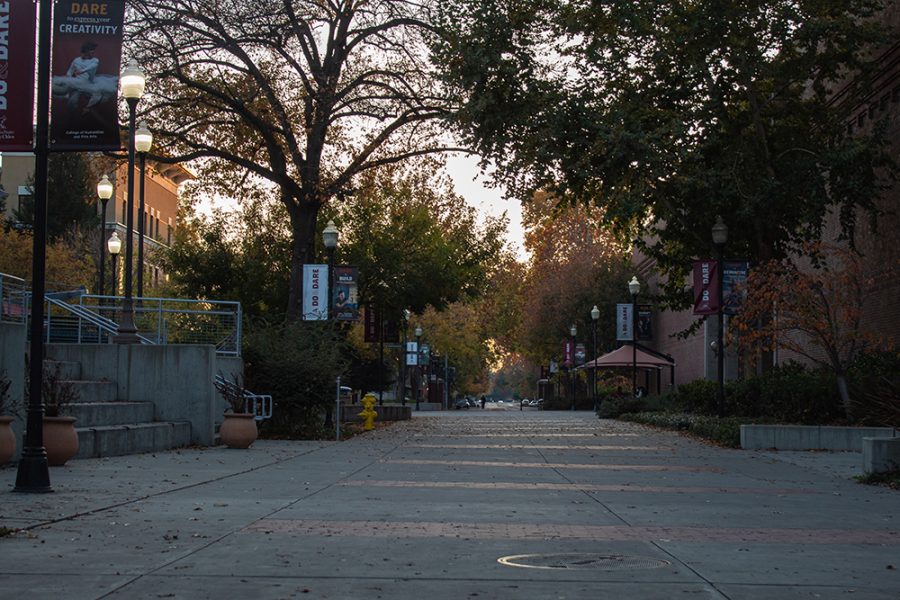
Ava Norgrove can be reached at [email protected]




